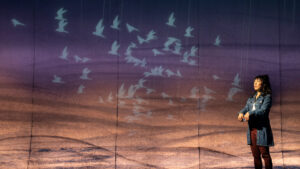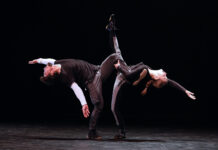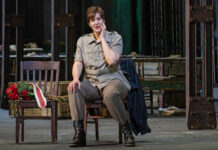
Many theatergoers took notice of playwright Rajiv Joseph in 2009 when his play, Bengal Tiger at the Baghdad Zoo, had its world premiere at the Kirk Douglas Theatre. He was a Pulitzer Prize finalist for the play which found its way to Broadway in 2011 with Robin Williams heading the cast.
In 2008, New York’s Second Stage Theater gave the world premiere production of Joseph’s play Animals Out of Paper. In that play an origami artist takes a teenage prodigy, Suresh, under her wing at the suggestion of his high school teacher.
Joseph has revisited the character of Suresh for his new play, Letters of Suresh, which is having its world-premiere at Second Stage Theater. The play continues through Sunday, October 24th.
Letters of Suresh is told via letters sent by Suresh to a priest in Nagasaki, Japan, whom he encountered in the first play. After Father Hiromoto’s passing, his grand-niece, Melody, has taken possession of a box of letters Suresh sent to him. She tries to figure out exactly who Suresh is to her great uncle and why all these letters exist in the first place.
Last week I spoke via Zoom with Joseph about his new play, the lost art of letter-writing and the parallels to be found in origami and playwriting. What follows are excerpts from our conversation that have been edited for length and clarity.
Origami master Robert J. Lang said “The secret to productivity in so many fields and in origami is letting dead people do your work for you because what you can do is take your problem and turn it into a problem that someone else has solved and used their solutions.” Do you agree and how much does that represent perhaps what Suresh is doing in Letters of Suresh?

I mean, that’s really interesting. Dead people. (LAUGHS) You know, I don’t know if that’s Suresh is doing. I think that is a really interesting observation by Robert Lang. I think that Suresh’s reckoning within this play is his own contribution and his own participation in a sort of violence or potential violence that can exist in the world. And I think that what we see in his letters to Father Hashimoto are, at first, kind of friendly getting to know you fuck off letters.
But then I think the play really begins when he writes to Father Hashimoto five years later. And I think therein begins his engagement with this priest. All the while wanting to ask or tell him something that he’s unable to do until the very end.
I think that most people who do origami and are passionate about it understand it on a metaphorical /perhaps spiritual level. They understand themselves in their folds and they understand the world in their folds. And I think that for me as the playwright, and also for Suresh, the examination of that talent is how he thinks about the world and also thinks about his own sort of complicity in his choices and the kind of business that he’s decided to go into.
Though he has major differences with Hashimoto, he still reaches out to him.
I think the reason that he always comes back to Hashimoto is because he understands Hashimoto has wisdom that he lacks. Even as he rails against Hashimoto’s religious tact or approach to life, he is curious about a different way of thinking, a different way of living. I think that the the characters in this play, not just Suresh and Hashimoto, but also Melody and Amelia, are all in these crisis points of trying to figure out a new way of approaching life. What’s interesting to me about spiritual thought is that if you begin to contemplate it in any way, there’s a sort of infinite reservoir of ideas that can come from it. And I think that that’s that’s what I see Suresh is looking for in Hashimoto.
In an era where we’re so used to texting and emailing, has society lost something, in your opinion, by not continuing in the tradition of writing letters?
Yeah, I think so. I think that we always lose when we gain something else. I’m not one to bad mouth technology. I rely on it as much as anybody else. But I spent three years in the Peace Corps between 1997 and 2000. When I went into the Peace Corps in ’97, I didn’t, and no one I knew, had an e-mail address. And when I returned in 2000, all of my friends and parents and families, they all had e-mail addresses and I had to suddenly get one. My main communication with my friends and family had been through letter writing and through receiving letters from all of them – handwritten on paper and put in an envelope with a stamp and sent across the ocean.
I wonder if I was the last class of Peace Corps volunteers that wrote letters. I still have them, and my parents gave me back the ones I wrote to them. I remember the way that I thought about communicating with people. It was so much deeper, I think. I still think that people have significant communication with each other, but it’s different.
I think that letter writing is a lost art form. To re-engage with it requires a sort of a purposeful fetish with the art rather than necessity. No one needs to write them anymore. So to do it is like going back to vinyl, which people do these days. It’s just going to take, if anyone is interested in doing it, a kind of purposeful reversion to an analog state.

Suresh says in one of his letters, “It’s strange how you can forget about the person you used to be.” I just stopped when I read that line because I started thinking who I used to be, which is something I don’t think we evaluate as we get older. We don’t look back. Do you think that forgetfulness about who we used to be is either a good or bad thing?
I think it’s a sad thing. I don’t think it’s good or bad. It may be a sad and necessary thing – maybe. I have letters, but I’ve also been keeping a journal pretty consistently for the past twenty five years or so since I graduated from college. Every so often I go back and just read entries from it and they always kind of stun me.
They stunned me in two ways. In some ways they stun me because I’m so similar to that. I am the same person I was. But then it stuns me what my life used to be like and how I used to live and how I used to kind of think and do things.
I think that we have this endless capacity to change, to improve and evolve. But I think that, like in that evolution, you can lose a sense of wonder or lose a sense of curiosity. So there are things to mourn and also things to be like, I’m glad that kid’s no longer be around because what an asshole!

In the very next letter, Melody says, “A few years ago when I was a different person.” I feel like there’s a call and response. I don’t know if that if that was intentional in the way you structured the letters, but it feels like we get opposing views of exactly that concept in back-to-back letters.
Absolutely. The Melody letter is actually the one that gets to the heart of it because in her case, it’s a very sad thing. She knew that she had this thing that she’s kind of not open for many years. And then the act of re-reading and re-reading Suresh’s letters has finally caused her to remember a mistake that she made that that sent her life in a different direction. I think everybody has those little moments. I know that I think about them sometimes. And I think that a lot of this is play is about considering the paths that have not been taken. For me this is really interesting.
Are there ways in which playwriting and origami are similar?
Absolutely. When you have origami you can fold the paper in half and and that can be a bird. You can be like that’s a bird. Then you can also have a crease pattern with hundreds and hundreds of folds, and that can be a three-dimensional bird. There’s not necessarily a corollary between complexity and beauty. I think that for me the most beautiful plays and the most beautiful origami are the surprising ones. And it’s not because they have so many folds or such a complicated structure, but it’s because somebody has taken a simple piece of paper and made something unexpected and beautiful out of it. And the more unique that design can be, and the more surprising it is, the more satisfying the work of art is.
For tickets to Letters of Suresh by Rajiv Joseph, please go here.
All production photos by Joan Marcus (Courtesy Second Stage Theater)











